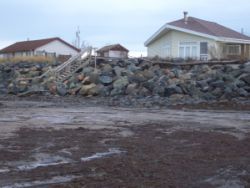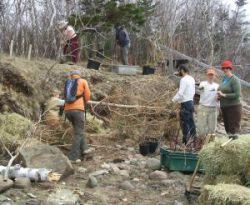Halifax Media Co-op
News from Nova Scotia's Grassroots
Living with the Shoreline, by Sadie Beaton and Emily LeGrand
This story was originally posted at Small Scales, the excellent East Coast fisheries blog administered by the Marine Issues Committee of the Ecology Action Centre. Follow the always interesting Marine Issues Committee on Twitter.
Let’s say you own a property along the coast. It’s not unlikely – seventy percent of Nova Scotians live in coastal communities. It is safe to say, then, that you’ve noticed some changes along the wetter edges of your property over time due to coastal erosion.
Coastal erosion is a natural process, an inevitable function of the ebb and flow of a living shoreline. It is necessary for the creation and maintenance of the beaches, salt marshes and mudflats that we all enjoy. In order to form a beach, sediment must be washed from the land in one place and carried by waves to the beach.
However natural, coastal erosion can still be worrisome to watch as it changes or shrinks the edge of your property. You may be especially concerned if these changes are approaching valuable infrastructure, like your home. Worse, the effects of climate change, including sea level rise and increasingly intense storms are expected to aggravate erosion rates along many of Nova Scotia’s most beautiful shorelines.
Unfortunately, though, our efforts to protect properties and infrastructure from erosion can have unintended effects. Maybe you’ve seen some of your neighbours “shoring up” their properties with rock armouring or other types of seawalls. ‘That looks like a lot of work’, you may have remarked quietly as you walked by with your dog. Or you may find it looks a bit… aggressive, or unnatural.
You may have also noticed that hard defensive approaches along the coast have led to some changes on or near your property. Because seawalls and other hard defenses break the connection between land and sea, they can lead to beach narrowing and accelerated erosion elsewhere along the coast. They can also harm shorebird habitat, degrade water quality, and reduce public beach access.
Happily, there is a middle way between watching your coastline chew ever closer to your seaside property and building a pricey coastal fortress. These practices can be cheaper and more attractive, are environmentally friendly, and will make you a more considerate neighbour. They also give you a chance to get to know your property and coastal surroundings better.
What are these magical techniques, you ask? “Living Shorelines,” a set of “soft” coastal stabilization techniques.
Living Shorelines practices address coastal erosion without severing the natural processes and connections between land and sea. Mimicking the slope and vegetation of natural shorelines, these techniques include strategically placing plants- along with other softer organic materials like haybales, brushwalls, or alder mats- along shrinking banks and slopes. They can also involve the protection or restoration of nearshore eelgrass beds, shellfish reefs, and salt marshes, which help dissipate wave energy before it reaches the coastline.
These alternative “softer” approaches can slow down erosion and help create shorelines that are more resilient, and can better withstand waves and storms. They can also help protect eelgrass beds, vital nursery habitat for juvenile fish, by keeping excess sediment out of the water. Best of all, Living Shorelines can actually improve the overall health of the coastal ecosystem you enjoy.
As a bonus, you may also find that applying these gentle, natural methods help deepen your relationship with your property, your neighbours, and with the coastal system as a whole. After all, Living Shorelines techniques do require some investment of time and energy. You are going to need to get to know your property a little better through taking walks up and down the beach, and noting changes after a big storm. You are also probably going to need to spend some time checking in with your neighbours about changes that you’ve been noticing. Finally, quality time will be spent replacing sod blankets and brushwalls that wash away in storms.
Over the last few years, the Ecology Action Centre has been running a Living Shorelines demonstration project. Staff and volunteers have been working with a team of local experts to adapt techniques that have proven successful elsewhere to a Nova Scotia context. There are three ongoing sites on private properties along the Northumberland Strait.
Several other local property owners, including Brian Hovis, have gotten involved in a more informal fashion. As Hovis explains, “I treated over 2,000 feet of shoreline bank this summer and I feel good about doing something to halt the erosion. At the same time, sea-level rise may eventually cause worse erosion. But I feel like we will be in a much better position than if I had done nothing.”
The EAC Living Shorelines project has also been creating and collecting a number of useful Living Shorelines resources. An excellent toolkit is available atwww.ecologyaction.ca/livingshorelines, including handy brochures, explanatory videos, and other useful resources for those living and working on the coast.
Of course, there is a bigger picture here. We can plant willows and lay sod blankets until the moon stops pulling the tides, but without a comprehensive coastal strategy, including development standards and land use planning regulations, our relationship with the coast will only grow more nerve-wracking, disrupting and expensive, for us, the coast and its creatures. Nova Scotia needs stronger measures in place to protect coastal ecosystems and habitat, maintain natural shoreline processes, and protect public and private infrastructure from climate change impacts. We also need accurate and accessible habitat sensitivity and erosion data for the entire coastline.
Many other coastal areas have recognized the potential consequences of a one-size fits-all approach to erosion control measures and have begun to create resources, policies and programs to support coastal management that works for people and the coast as a living system. Maryland, for example, enacted a “Living Shorelines Protection Act” in 2008. This requires coastal property owners to use a Living Shorelines approach to coastal stabilization unless the owner can demonstrate that these approaches are not feasible for their area or that their area has been designated highly erodible. Unfortunately in Nova Scotia, because our coastline has not been mapped and classified according to erodibility, it is difficult to consider such a progressive act here in the near future.
Our nearer neighbor Maine has mapped its coastline for eroding bluff type and made these maps accessible for the interested public so that coastal properties owners there can look up their property on a map and interpret their erosion risk to help people navigate coastal living. The state has also developed good regulations under its “Mandatory Shoreland Zoning Act.”
After spending time indoors, maybe penning a note to remind our provincial government about the need to complete our comprehensive coastal planning act, maybe you’ll want to take a little walk around the coastal perimeter of your property. Where have you noticed changes? Do you see any areas that might benefit from Living Shorelines techniques?
If you decide to use Living Shorelines practices on your coastal property, you can feel proud to be part of the living coast. You’ll be moving and changing with a glorious and dynamic system that we share with not only our human neighbours, but many other species, from the sand dollar to the puffin. But living right in the midst of an ever-changing ecosystem is not easy. Over time, you may find yourself reconsidering your very natural emotional (not to mention financial) attachment to your property. Respecting the coasts’ need to move and change may best happen at a greater distance, and help avoid the expensive and stressful conflicts with the wind and the waves.
Sadie Beaton curates the SmallScales.ca blog and dreams of sleeping on a bed of eelgrass. Emily LeGrand coordinates Living Shorelines educational events and resources and can’t help but place seaweed on exposed soil while walking on the beach.
The site for the Halifax local of The Media Co-op has been archived and will no longer be updated. Please visit the main Media Co-op website to learn more about the organization.





